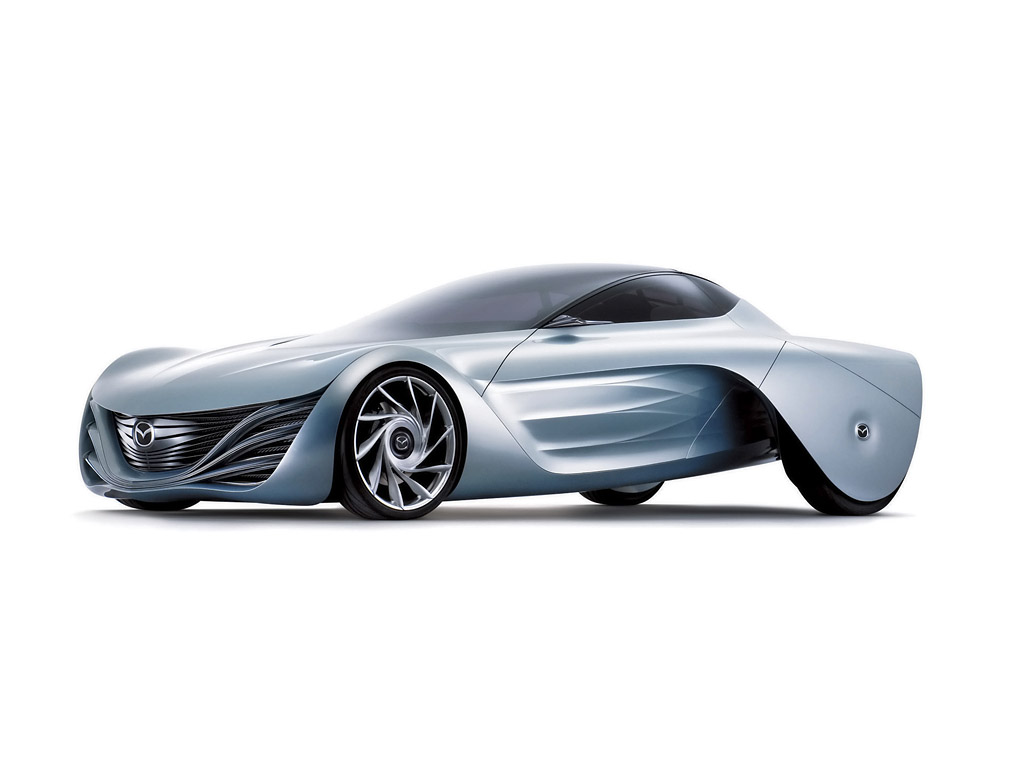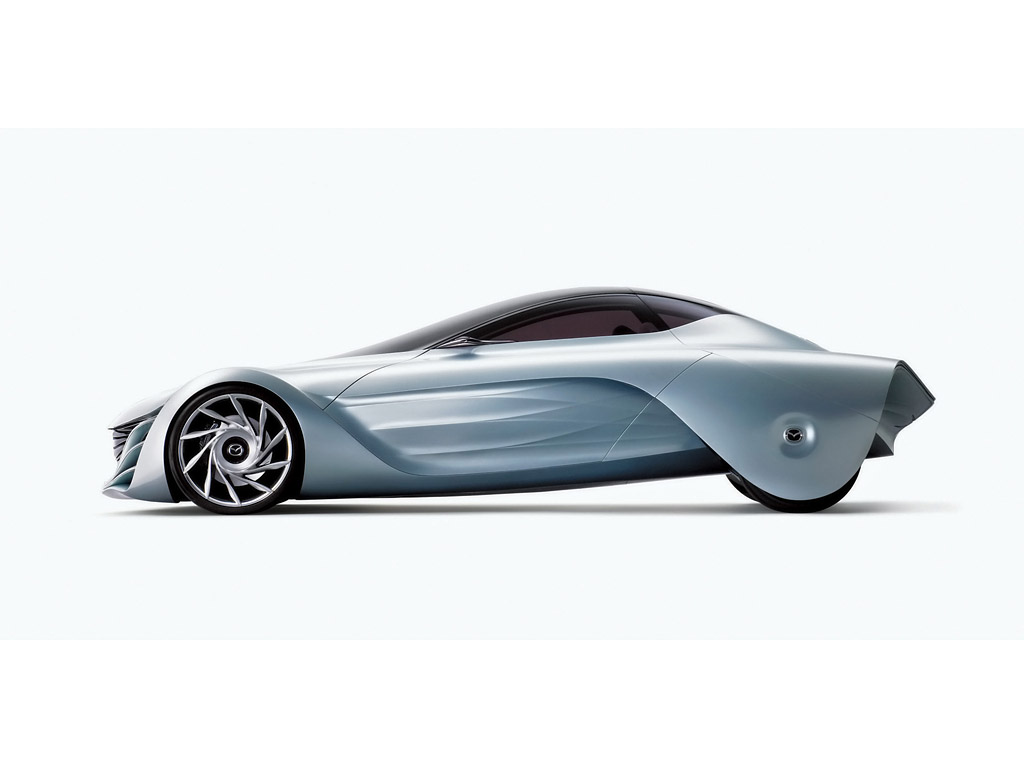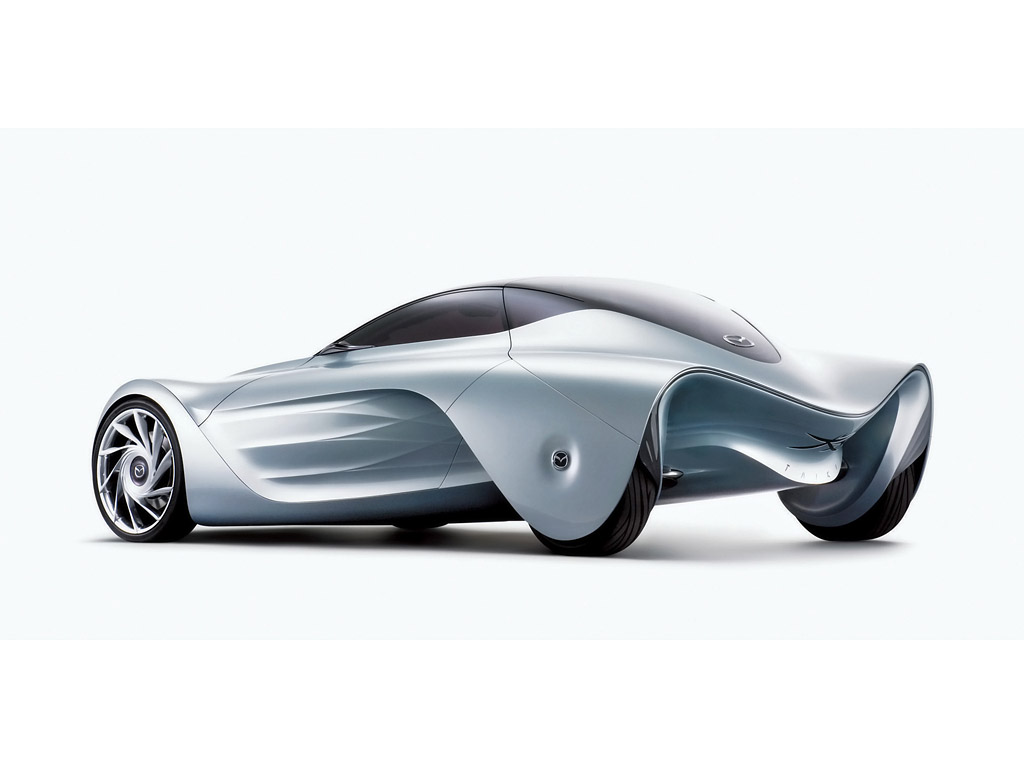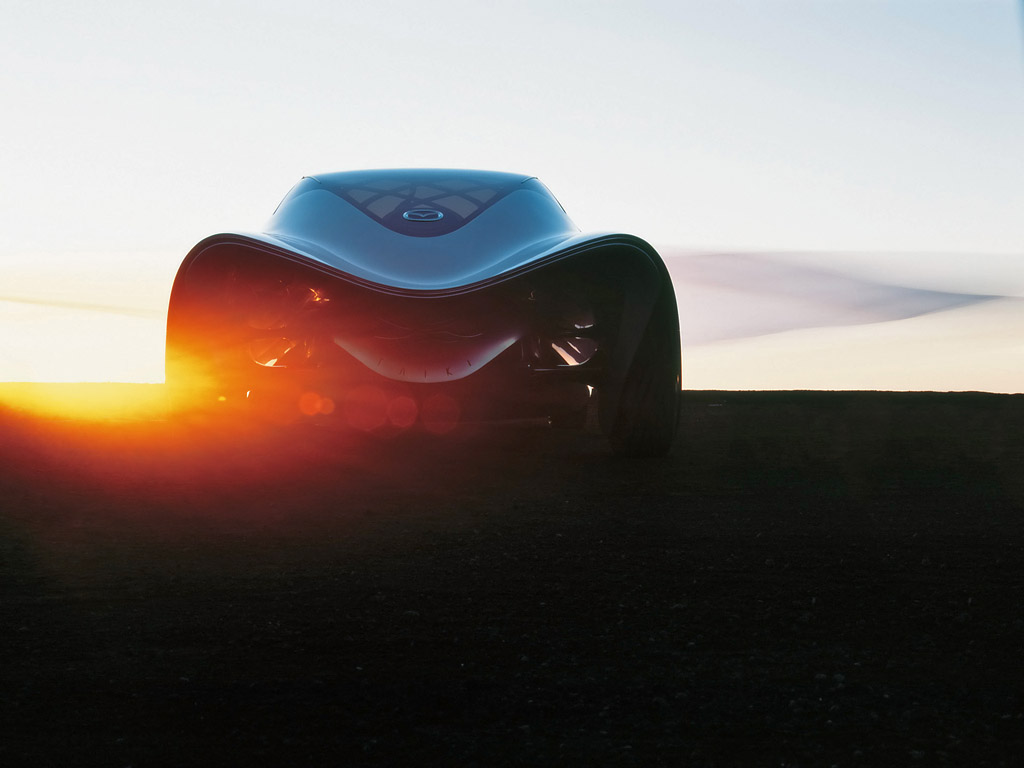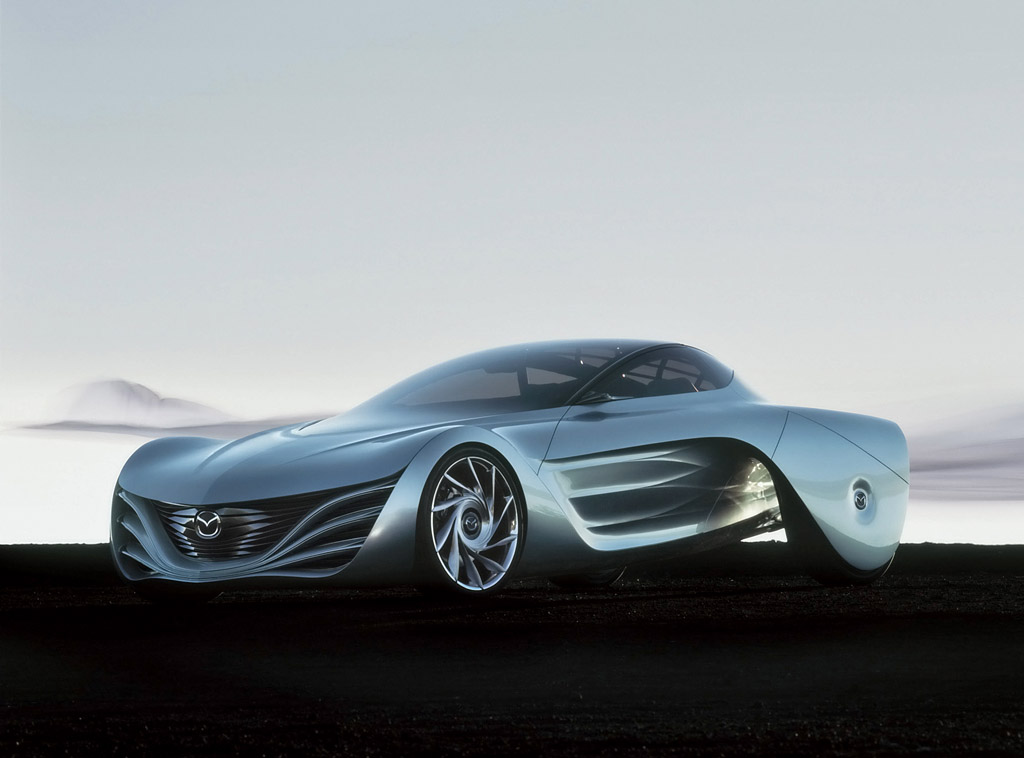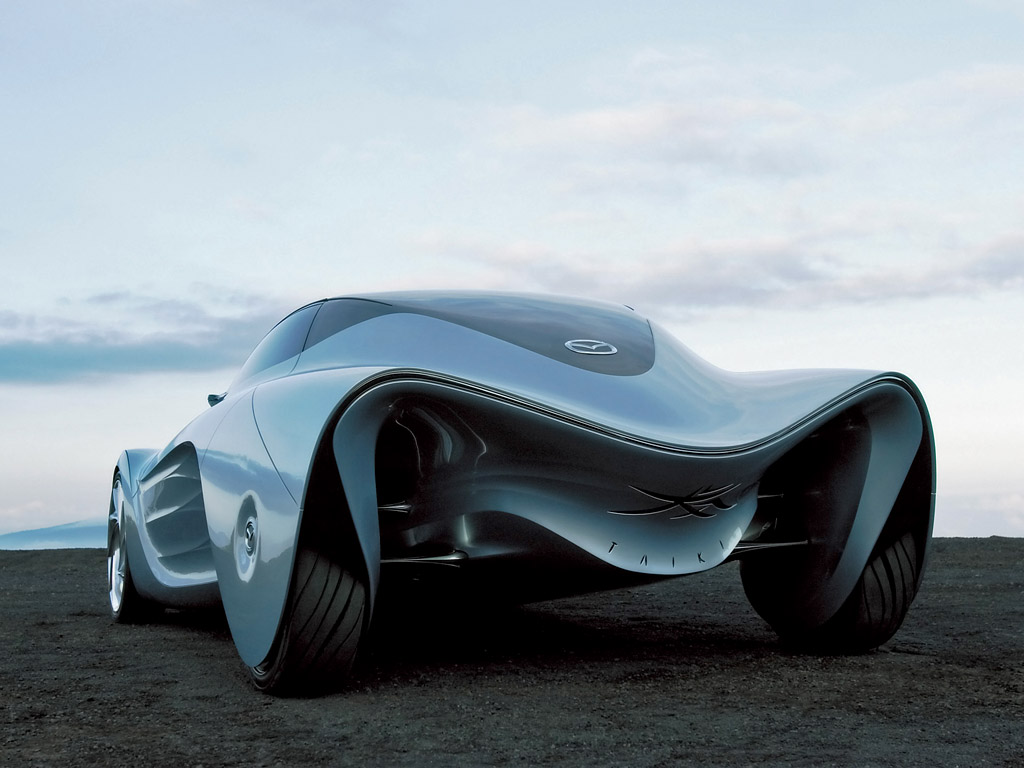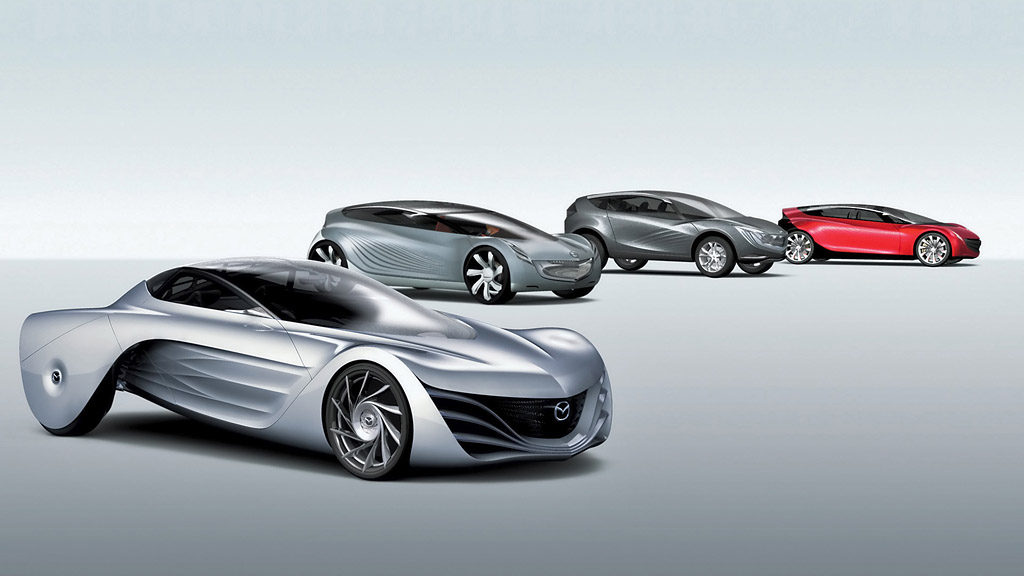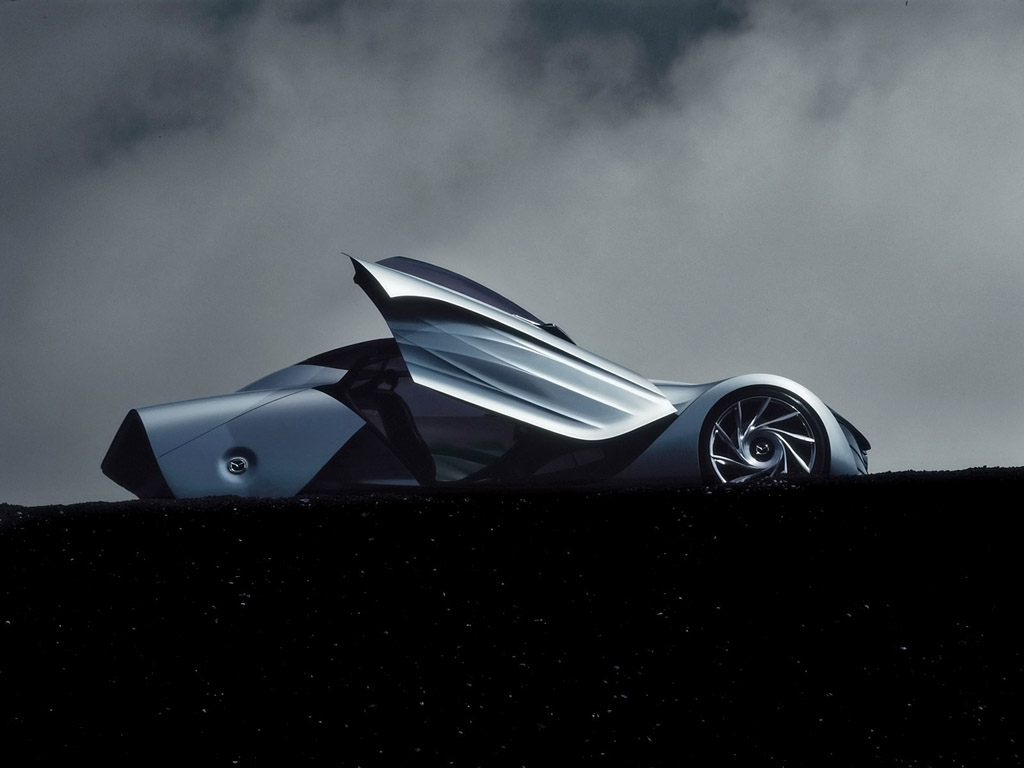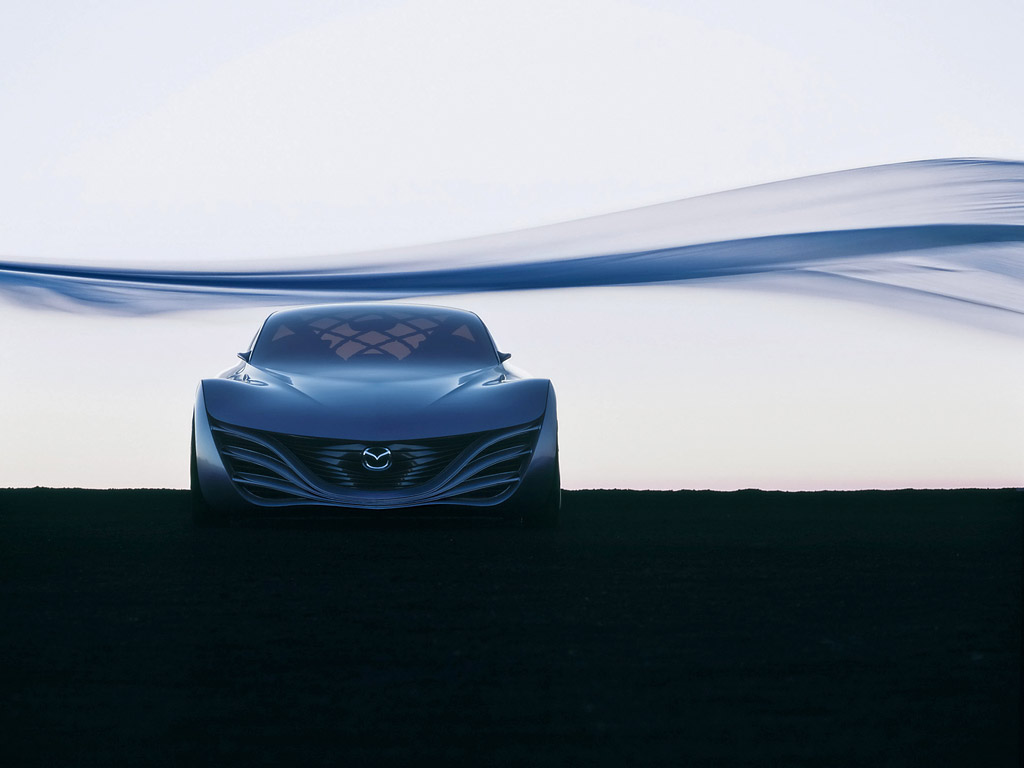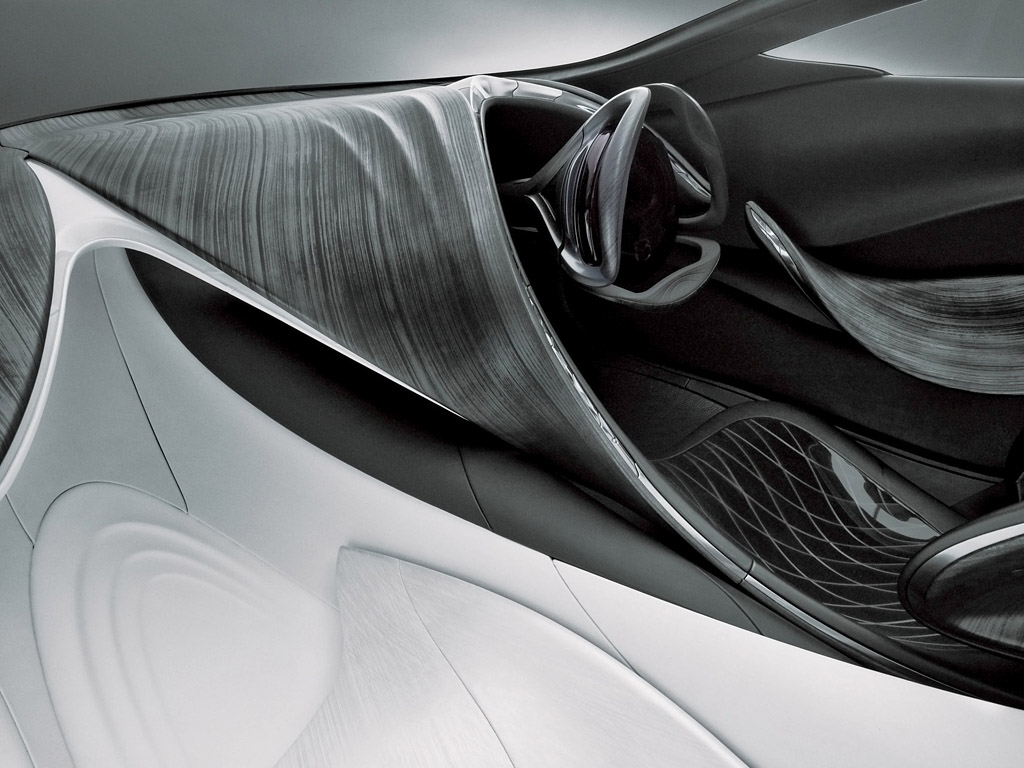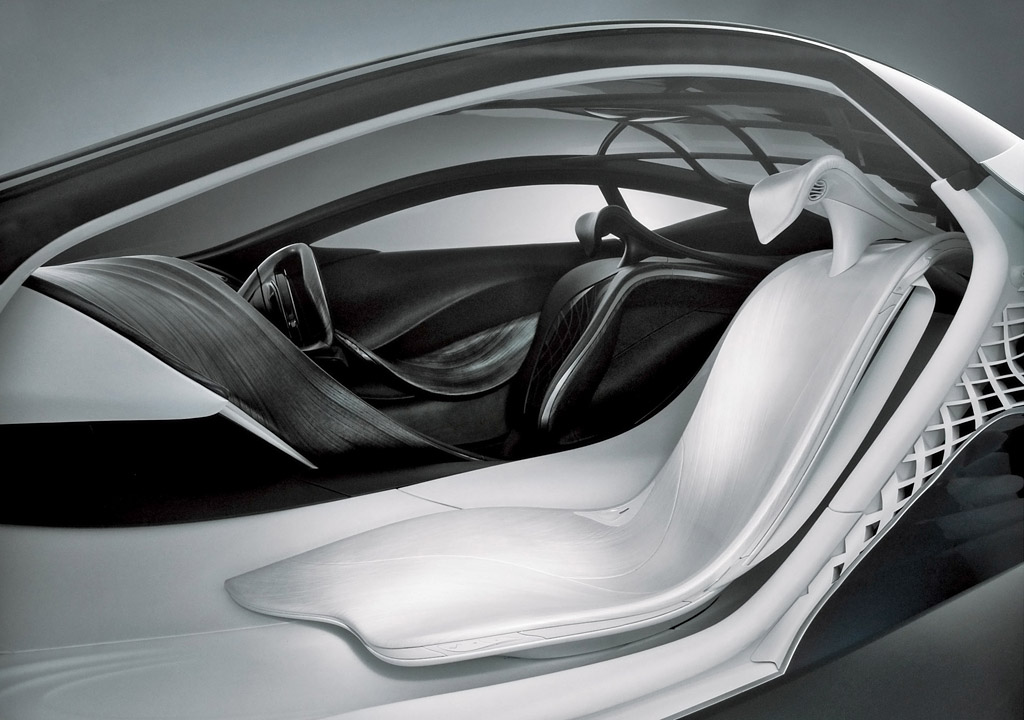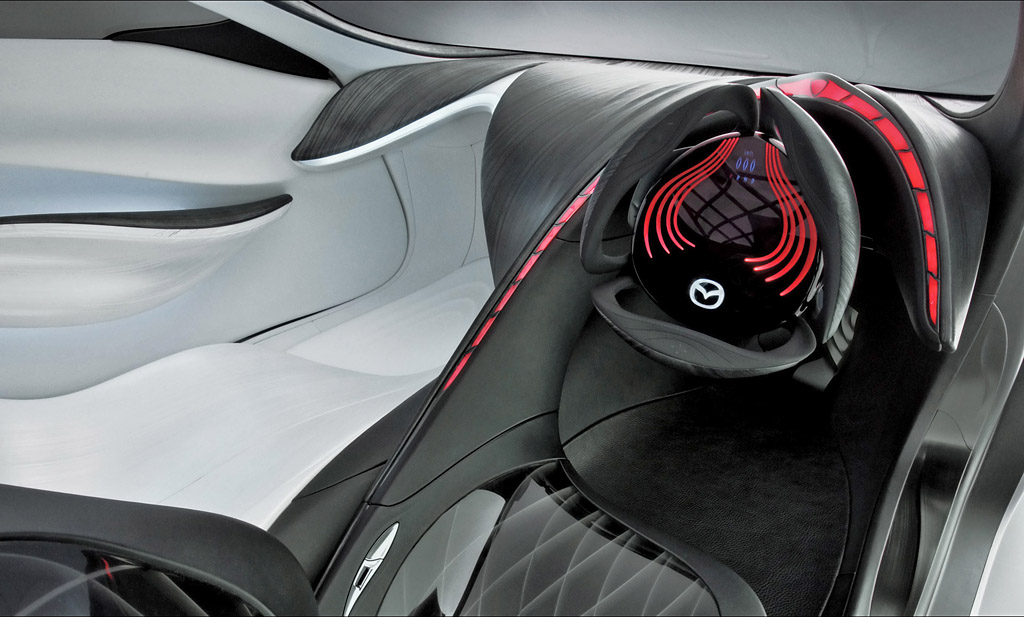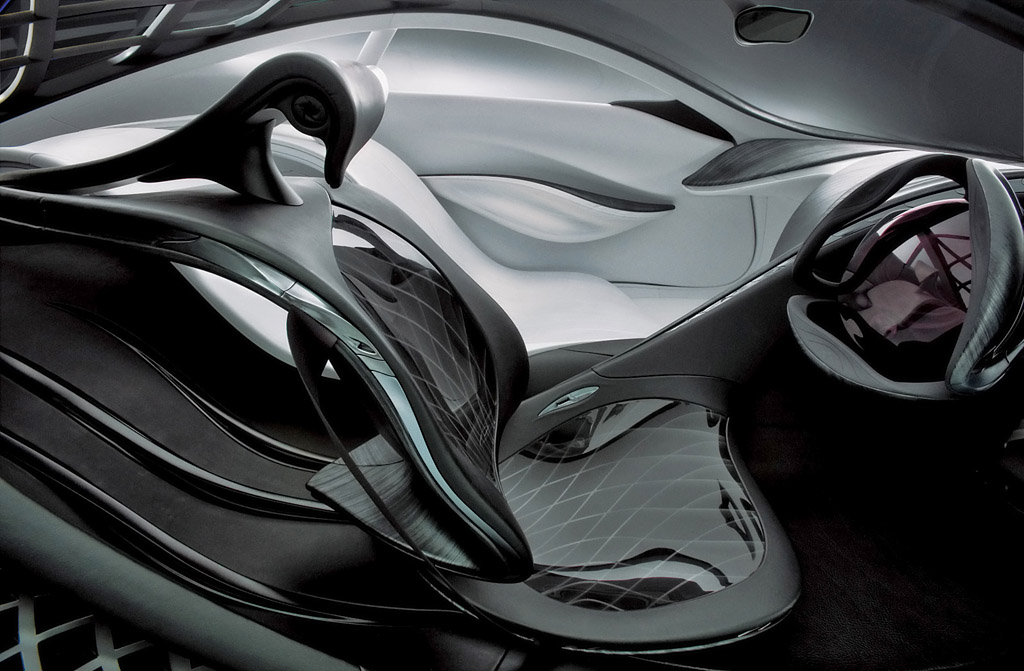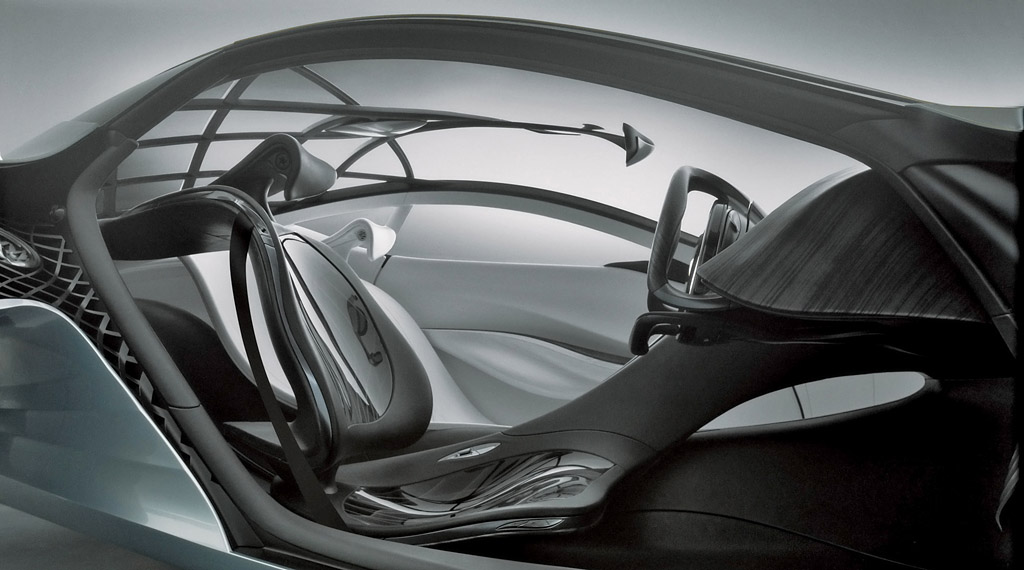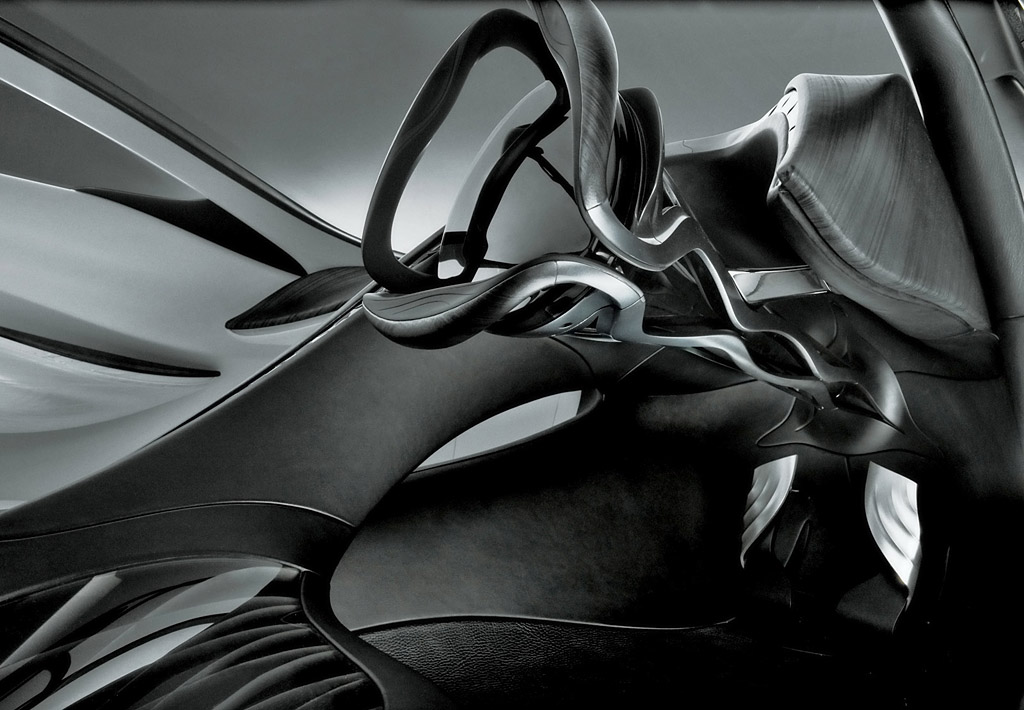2007 Mazda Taiki Concept
Oct 2nd, 2007 – The all-new, the Mazda Taiki concept car, equipped with a next-generation rotary engine will all be revealed by Mazda Motor Corporation at the 40th Tokyo Motor Show on 24 October 2007.
Mazda Taiki reflects one possible direction for a future generation of Mazda sports cars aimed at helping create a sustainable society. The fourth concept car in the Nagare design series, Mazda Taiki further evolves the flow theme to establish a breathtaking presence that clearly distinguishes it as the next in the series, and which visually expresses the atmosphere – called taiki in Japanese – that wraps the Earth in its protective mantle.
The basic proportions begin with the stretched coupe form of a front-engine rear-wheel-drive layout, the short overhangs, and the liberating feel of an all-glass canopy. The challenge to create ”a design that visually expresses the flow of air” was inspired by the image of a pair of Hagoromo – the flowing robes that enable a celestial maiden to fly in Japanese legend – floating down from the sky.
Inspired by Japanese koinobori � the decorative ‘climbing carp streamers’ the notion of creating an Air-tube became the concept word for the interior design. In accordance, from the dashboard and seats down to the door trim, the interior space creates the dynamic sensation that the flow of the wind is being visually depicted.
Centering around the performance rotary engine sports packaging that is synonymous with the Mazda name, technologies introduced for the Mazda Taiki include the next-generation RENESIS (rotary engine 16X), which sets new standards for environmental and driving performance, a front-engine rear-drive layout, a unique 2-seat configuration, and Mazda’s rotary sports package, which conveys an image of lightness. The effect integrates the design theme perfectly to realize outstanding aerodynamic performance.
Mazda Taiki Concept – aimed at helping create a sustainable society
Mazda Taiki reflects one possible direction for a future generation of Mazda sports cars aimed at helping create a sustainable society. The fourth concept car in the Nagare design series, Mazda Taiki, further evolves the �flow� theme to establish a breathtaking presence that clearly defines its Nagare credentials, and visually expresses the atmosphere – called taiki in Japanese – that wraps the Earth in its protective mantle. Centering around the performance rotary engine sports packaging that is synonymous with the Mazda name, technologies introduced for the Mazda Taiki include the next-generation RENESIS (rotary engine 16X, refer to book separate volume for details), which sets new standards for environmental and driving performance, a front-engine rear-wheel-drive layout, unique 2-seat configuration, and others which convey an image of lightness. The effect integrates perfectly the design theme to realize unbeatable aerodynamic performance.
An evolution of Nagare design; the form of a car that operates in harmony with the environment; the creation of an iconic Mazda sports car symbolized by its next-generation RENESIS. To bring these concepts together and create a design worthy of the Nagare design series, chief designer Atsuhiko Yamada presented his team with a single objective: create �a design that visually expresses the flow of air�.
”The preceding three concept cars in the Nagare series each took a hint from nature, such as the flow of water or the patterned surface of wind-swept sand dunes. In contrast, we wanted the concept car for the Tokyo Motor Show to convey both the beauty and power of nature, while also emphasizing the importance and the wonderful splendor of our environment. That led to our focusing on the air that blankets our planet and our desire to apply Nagare design in visually representing this entity, which is normally invisible to the eye.”, Chief Designer Atsuhiko Yamada’s words summarize, and as the very name of the concept car makes clear, Mazda Taiki’s futuristic design embodies Mazda�s determination to build cars that contribute to the realization of a sustainable society.
The challenge to create ‘a design that visually expresses the flow of air’ was inspired by the image of a pair of Hagoromo – the flowing robes that enable a celestial maiden to fly in Japanese legend – floating down from the sky. In addition to drawing sketch after sketch in various attempts to capture the right look, the designers also tried unique approaches, such as soaking cloth in plaster and then hanging it to dry while flapping in the wind, thereby capturing the motion of air in solid form. This gave birth to an innovative design, one with a nimble, light appearance and flowing contours that naturally capture the hearts and imaginations of those who see it.
The basic proportions begin with the stretched coupe form of a front-engine rear-wheel -drive layout, the short overhangs, and the liberating feel of the all-glass canopy, which combine to express a harmony of elegance and sportiness. The lower of the layered hagoromo flows from the front fenders to the sides, where it wraps under the body and gracefully curves up at the rear. The other hagoromo flows from the hood through the shoulder lines it etches, past the unique independent rear fender design, and lends a seductive curve to the rear deck. The fusion of these flowing upper and lower surfaces not only creates a visual depiction of flowing air, it also minimizes body volume for a trim, well-toned appearance, as well as creating a sense of floating lightly on air. This sensation is further amplified by the Ozonic Silver paint that was specially developed for this project. The outer panels of the doors that open widely toward the front form a relief that symbolizes the accelerating flow of air actually experienced by the designer during wind tunnel tests.
The design team sought to achieve an extremely high level of aerodynamic performance through a combination of design and technologies. A bird’s-eye view of the Mazda Taiki body shows how much its width is tapered from front to rear. From the side, one sees the smooth line of the flat underside kick up dramatically at the rear of the body. Validating the designer’s wish to visually capture the motion of flowing air, wind tunnel testing proved the excellent aerodynamic performance inherent in the design. The distinctive shape around the rear wheels, which channels air flowing back from the front fender through a ‘tunnel’ formed between the body and rear fender, also proved effective in creating downforce. The already high aerodynamic potential of the original form was then fine tuned, the end result being an excellent drag coefficient of 0.25 and zero lift.
The edges of the blades that comprise the grille are fitted with ultra-fine rows of brilliant LEDs. The rear combination lamps and door-mounted turn signal lamps employ unique Mazda technology and appear to shine through the body color but are distinguishable only when lit. The effect throughout creates the illusion of flowing air being transformed into lights visible to the human eye.
The edges of the blades that comprise the grille are fitted with ultra-fine rows of brilliant LEDs. The rear combination lamps and door-mounted turn signal lamps employ unique Mazda technology and appear to shine through the body color but are distinguishable only when lit. The effect throughout creates the illusion of flowing air being transformed into lights visible to the human eye.
A collaborative effort with the tire designers and engineers created 22-inch tires for the Mazda Taiki that are dynamic in size and feature a bold tread pattern modeled after a flowing motif. The turbine wheel design was inspired by the turbo fan blades of a jet engine and developed in close collaboration with wheel engineers to create a unique design.
Koinobori interior design
Inspired by Japanese koinobori – the decorative ‘climbing carp streamers’ that fly proudly in the early May skies of Japan- the notion of creating an Air-tube became the concept word for the interior design. In accordance, everything from the dashboard and seats down to the door trim creates the dynamic sensation that the flow of the wind is being visually depicted. At the same time, the design team created a unique ambience for each half of the interior. The colors and materials clearly divide the cabin into black and white zones, and the strength of the design lines expresses a dynamic yet gentle quality.
On the driver’s side, the dashboard twists in dynamic fashion and continues on the cushion of the driver’s seat. The independent seatback and headrest also create a new expression of flowing lightly, as though on a breeze. Black trim used as the keynote color, creates an environment that better helps the driver concentrate on driving.
The passenger ‘zone’ provides the relaxing comfort of a lounge chair surrounded by plenty of legroom. The white trim color helps accent the resulting expression of roomy comfort that truly befits a passenger seat.
The design concept aims for a new form of sports car cabin. The center shelf between the driver and passenger seats can be effectively used as flexible utility space.
Interior details that emphasize flow
The cabin precludes any sense of symmetry or adherence to any prescribed design doctrine. Each part embodies flowing wind, instilling a light, airy feel, that also creates an organic, dream-like ambience.
Structural beauty with emotion
The transparent teardrop roof that covers the cabin is reinforced by a truss frame with flowing contours that constitute one part of the body structure. The same design theme is also applied to the steering column and seat frame of the driver’s seat. To make the beautiful contours of this frame design clearly visible, the cushion and back for the driver’s seat are made from a clear elastic silicone plastic material.
Zen calligraphy with a shine
The black and white genuine leather of the interior features flowing calligraphic strokes painted on the surface using a gloss paint that contains metallic pigment. A new technique developed through collaboration with textile designers allowed an artist to use a brush to visually recreate the flow of the wind. The lines follow the contours of the dashboard and seats to further emphasize the sense of flow. The material surface is coated using a process that is unique to Mazda.
(Cooperation: NUNO Corporation)
Extending gracefully to embrace the steering wheel and driver’s seat, the respective edges of the dashboard each feature a row of red LEDs that function as the tachometer. Streams of red light flow toward the front on either side of the driver to visually depict leaps in engine RPM. The result is dynamic visual feedback that expresses the emotion of driving.
Extending gracefully to embrace the steering wheel and driver’s seat, the respective edges of the dashboard each feature a row of red LEDs that function as the tachometer. Streams of red light flow toward the front on either side of the driver to visually depict leaps in engine RPM. The result is dynamic visual feedback that expresses the emotion of driving.
To further advance safety performance and take it to new levels for the future, Mazda is actively working on an HMI that will make communication between driver and machine smoother and easier, as well as further developing advanced active safety technologies. Multi-control switches for the respective systems are integrated into the rotary-inspired steering wheel in a design that allows drivers to perform all driving operations without removing their hands from the steering wheel. Also integrated into the steering wheel is a multi-display that provides the driver with a variety of information displays.
To further advance safety performance and take it to new levels for the future, Mazda is actively working on an HMI that will make communication between driver and machine smoother and easier, as well as further developing advanced active safety technologies. Multi-control switches for the respective systems are integrated into the rotary-inspired steering wheel in a design that allows drivers to perform all driving operations without removing their hands from the steering wheel. Also integrated into the steering wheel is a multi-display that provides the driver with a variety of information displays.
Story by Mazda
In Detail
| submitted by | Richard Owen |
| engine | Next Generation RENESIS |
| front tires | 195/40 R22 YOKOHAMA ADVAN Super-E spec PROTOTYPE 007 |
| rear tires | 195/40 R22 YOKOHAMA ADVAN Super-E spec PROTOTYPE 007 |
| f brake size | mm / in |
| r brake size | mm / in |
| f suspension | Double wishbone |
| r suspension | Double wishbone |
| wheelbase | 3000 mm / 118.1 in |
| length | 4260 mm / 167.7 in |
| width | 1950 mm / 78.0 in |
| height | 1240 mm / 48.8 in |
| transmission | Dry twin clutch 7-speed power shift |
| gear ratios | :1 |






